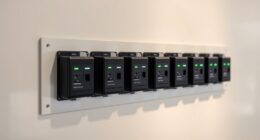If you’re looking for the best multi-room Wi-Fi mesh systems, I recommend considering options like the TP-Link Deco BE25, which supports WiFi 7 with speeds up to 5 Gbps and covers large homes. The Linksys Velop, NETGEAR Orbi 370, and Amazon eero 7 are also excellent choices, offering extensive coverage and high device capacity. Many systems feature easy setup, strong security, wired backhaul options, and future-proof Wi-Fi 7 support. Keep exploring to find the perfect fit for your home.
Key Takeaways
- Top mesh systems like TP-Link Deco BE25, NETGEAR Orbi, and Linksys Velop offer extensive coverage up to 8,000 sq. ft. for large homes.
- Advanced Wi-Fi 7 and Wi-Fi 6E models deliver multi-gig speeds and support over 150 devices simultaneously.
- Easy setup and management via dedicated apps ensure seamless installation and network control across all nodes.
- Multi-link operation, wired backhaul options, and multi-gig ports enhance stability and future-proof your home network.
- Built-in security features like WPA3, automatic updates, and parental controls protect your entire mesh Wi-Fi system.
TP-Link Deco BE25 Dual-Band WiFi 7 Mesh System (3-Pack)
If you’re looking for a mesh system that can handle heavy internet usage across a large home, the TP-Link Deco BE25 Dual-Band WiFi 7 Mesh System (3-Pack) is an excellent choice. It delivers fast speeds up to 5 Gbps with 4 streams, optimized for WiFi 7 devices like the latest iPhones and gaming consoles. With Multi-Link Operation, 4K-QAM, and support for over 150 devices, it ensures smooth performance even during peak usage. Covering up to 6,600 sq. ft., it offers reliable, seamless connectivity through its high-gain antennas and wired ports. Plus, AI-Driven roaming keeps your devices connected effortlessly as you move around your home.
Best For: households needing high-speed, reliable WiFi coverage across large areas with multiple devices, including gaming, streaming, and smart home applications.
Pros:
- Supports WiFi 7 technology with speeds up to 5 Gbps and over 150 devices simultaneously.
- Extensive coverage of up to 6,600 sq. ft. with seamless mesh networking and AI-Driven roaming.
- Equipped with wired 2.5 Gbps ports for high-speed backhaul and multi-gig internet support.
Cons:
- Higher price point compared to basic WiFi systems due to advanced features.
- May be more complex to set up for users unfamiliar with mesh networks and networking configurations.
- Requires compatible WiFi 7 devices to fully leverage its advanced capabilities.
Linksys Velop Mesh WiFi System
The Linksys Velop Mesh WiFi System is an excellent choice for large households that need seamless, reliable internet coverage across multiple floors and outdoor areas. Covering up to 6,000 sq. ft. with a 3-pack, it supports over 60 devices and delivers speeds up to 2.2Gbps thanks to tri-band connectivity. Unlike traditional routers, Velop uses wireless mesh networking to eliminate dead zones and guarantee stable connections everywhere. Setup is straightforward through the Linksys app, and the system is compatible with Apple HomeKit and Alexa for easy voice control. It’s ideal for streaming, gaming, and managing multiple devices without interruptions.
Best For: large households or multi-story homes needing seamless, reliable Wi-Fi coverage for multiple devices and high-bandwidth activities.
Pros:
- Covers up to 6,000 sq. ft. with a 3-pack, ideal for large spaces
- Supports over 60 devices with speeds up to 2.2Gbps thanks to tri-band connectivity
- Easy app-based setup with seamless expansion by adding more nodes
Cons:
- May require some technical knowledge for optimal setup and management
- Higher initial cost compared to traditional routers or extenders
- Limited to Wi-Fi coverage; wired options or additional solutions needed for certain devices or environments
TP-Link Deco BE23 Dual-Band WiFi 7 Mesh System (2-Pack)
For anyone seeking a high-performance mesh Wi-Fi system capable of handling multiple devices and extensive coverage, the TP-Link Deco BE23 Dual-Band WiFi 7 Mesh System stands out. It leverages the latest Wi-Fi 7 technology, including Multi-Link Operation and 4K-QAM, delivering speeds up to 2882 Mbps on 5GHz and 688 Mbps on 2.4GHz. The system covers up to 4,500 sq. ft. with two units, supporting around 150 devices. Each node has four high-gain antennas and two 2.5 Gbps wired ports, ensuring reliable, fast connections across large homes. Advanced backhaul and security features make it a smart choice for modern, connected households.
Best For: households or small to medium-sized homes requiring high-speed, reliable Wi-Fi coverage for numerous devices and modern applications.
Pros:
- Supports Wi-Fi 7 with speeds up to 2882 Mbps on 5GHz, ideal for demanding activities like gaming and streaming.
- Seamless coverage up to 4,500 sq. ft. for large homes with support for around 150 devices.
- Advanced security features including HomeShield, parental controls, and real-time IoT protection.
Cons:
- Higher price point compared to traditional Wi-Fi systems due to advanced technology.
- Requires compatible devices to fully utilize Wi-Fi 7 features; older devices may not benefit from all improvements.
- Setup and management may be more complex for users unfamiliar with mesh networking technology.
NETGEAR Orbi 370 Series WiFi 7 Mesh Network System
The NETGEAR Orbi 370 Series WiFi 7 Mesh Network System stands out as the ideal choice for large households or tech enthusiasts who demand high-speed, reliable coverage across multiple rooms and devices. It delivers speeds up to 5 Gbps, supporting up to 70 devices over 8,000 sq.ft., perfect for streaming, gaming, and remote work. The system is easy to set up via an app and includes features like enhanced backhaul, high-performance antennas, and a 2.5Gbps port for ultra-fast internet plans. Built-in security, automatic updates, and compatibility with any ISP make it a future-proof, dependable solution for seamless, whole-home WiFi.
Best For: households or tech enthusiasts needing ultra-fast, reliable WiFi coverage across large, multi-story homes with many connected devices.
Pros:
- Delivers speeds up to 5 Gbps and supports up to 70 devices over 8,000 sq.ft.
- Easy to set up with app-guided installation and user-friendly interface
- Built-in security features like Armor and Bitdefender provide comprehensive protection
Cons:
- High price point compared to other mesh systems
- Occasional satellite disconnects may require troubleshooting or rebooting
- Limited customization options for network settings, such as username changes
Amazon eero 7 Dual-Band Mesh Wi-Fi 7 Router (2-Pack)
Looking for a reliable mesh system that can handle the latest internet speeds and connect multiple devices seamlessly? The Amazon eero 7 Dual-Band Mesh Wi-Fi 7 Router (2-Pack) is a standout choice. It supports internet plans up to 2.5 Gbps and delivers Wi-Fi speeds up to 1.8 Gbps using advanced Wi-Fi 7 features. Covering up to 4,000 sq. ft. and supporting over 120 devices, it ensures reliable, high-speed connectivity throughout large homes. With patented TrueMesh technology and easy backward compatibility, it minimizes dead spots and network disruptions, making it a smart, future-proof investment for seamless home coverage.
Best For: Homeowners and tech enthusiasts seeking a reliable, high-speed mesh Wi-Fi system that supports multiple devices and covers large areas with future-proof technology.
Pros:
- Supports internet plans up to 2.5 Gbps with Wi-Fi speeds up to 1.8 Gbps, ensuring fast and efficient connectivity.
- Covers up to 4,000 sq. ft. and supports over 120 devices, ideal for large homes and busy households.
- Incorporates advanced features like TrueMesh, TrueRoam, and TrueChannel for reliable, optimized network performance.
Cons:
- The 2-pack may require additional units for very large or multi-story homes beyond 4,000 sq. ft.
- Slightly higher price point compared to traditional routers, which could be a consideration for budget-conscious buyers.
- Setup may be more complex for users unfamiliar with mesh networking technology.
TP-Link Deco S4 Mesh WiFi System (3-Pack)
If you’re seeking an affordable yet reliable mesh WiFi system capable of covering large homes or multi-building properties, the TP-Link Deco S4 Mesh WiFi System (3-Pack) is an excellent choice. It offers seamless coverage up to 5,500 square feet with three units forming a strong mesh network. Deco Mesh technology guarantees fast speeds and strong signals everywhere, eliminating dead zones. Each unit supports dual-band AC1900 speeds and can handle up to 100 devices simultaneously. Easy to set up via the Deco app, it also supports wired Ethernet backhaul for enhanced performance. Its compatibility with major ISPs makes it a versatile, cost-effective solution for extensive home coverage.
Best For: households or multi-building properties seeking an affordable, reliable mesh WiFi system with extensive coverage and easy setup.
Pros:
- Covers up to 5,500 sq ft seamlessly with three units forming a strong mesh network
- Supports dual-band AC1900 speeds and up to 100 devices simultaneously
- Easy setup and management via the user-friendly Deco app, with options for wired Ethernet backhaul
Cons:
- Firmware updates may require manual installation as automatic updates via the app can fail
- Limited advanced features and customization options compared to higher-end systems
- Some users experience issues with app-based management and firmware stability over time
TP-Link Deco WiFi 6 Mesh System (Deco X20)
Wondering which Wi-Fi mesh system can reliably cover a large home with multiple devices? The TP-Link Deco WiFi 6 Mesh System (Deco X20) is an excellent choice. It covers up to 5800 square feet with a 3-pack and uses Wi-Fi 6 AX1800 technology for faster, more stable connections. Each unit has 2 Gigabit Ethernet ports, allowing wired backhaul for improved speed. Supporting up to 150 devices, it handles busy households with smart TVs, gaming, and smart home gadgets effortlessly. Setup is quick via the Deco app, and seamless roaming keeps your devices connected as you move around. It’s reliable, cost-effective, and perfect for large, device-heavy homes.
Best For: households seeking extensive, reliable Wi-Fi coverage with multiple connected devices in large or tech-heavy homes.
Pros:
- Seamless whole-home coverage up to 5800 sq ft with a 3-pack system
- Supports up to 150 devices, ideal for busy households and smart homes
- Easy setup via the Deco app with features like parental controls and voice commands
Cons:
- Proper placement of nodes is necessary to maximize coverage and speed
- May be more expensive than traditional routers for some users
- Performance can vary depending on home layout and interference factors
Amazon eero 6+ Mesh Wi-Fi System (3-Pack)
The Amazon eero 6+ Mesh Wi-Fi System (3-Pack) is an excellent choice for households that need reliable, high-speed internet coverage across multiple rooms and outdoor spaces. It delivers gigabit speeds supporting plans up to 1 Gbps and covers up to 4,500 square feet. With support for Wi-Fi 6, it handles over 75 devices seamlessly, making it ideal for busy smart homes. The system includes built-in Zigbee and Thread hubs for smart device integration, plus strong security features like WPA3. Setup is quick via the eero app, and its TrueMesh technology guarantees consistent, reliable coverage with minimal dead zones. It’s a versatile, user-friendly solution for demanding households.
Best For: households seeking reliable, high-speed Wi-Fi coverage across large or multi-story homes with many connected devices.
Pros:
- Supports gigabit speeds up to 1 Gbps and covers up to 4,500 sq ft for extensive coverage
- Seamless setup via the user-friendly eero app with automatic updates for security and performance
- Handles over 75 devices simultaneously, ideal for smart homes with multiple gadgets
Cons:
- Mixed compatibility with older eero models or MoCA adapters may affect bandwidth distribution
- Subscription required for advanced security features through eero Plus
- Optimal performance depends on proper placement and wired connections on each floor
Amazon eero 6 Mesh WiFi System (3-Pack)
The Amazon eero 6 Mesh WiFi System (3-Pack) stands out as an excellent choice for large households or homes with multiple smart devices, thanks to its support for over 75 devices simultaneously and coverage up to 5,000 square feet. It utilizes Wi-Fi 6 dual-band technology, delivering faster speeds and reliable connections for streaming, gaming, and video calls. Setup is quick via the eero app, which also allows remote management and easy expansion. With security features like WPA3 and Zigbee integration, it’s a versatile, secure system. Despite some limitations, its seamless coverage and user-friendly management make it a top pick for all-encompassing home Wi-Fi.
Best For: households requiring extensive Wi-Fi coverage and reliable connectivity for multiple smart devices and high-bandwidth activities.
Pros:
- Supports over 75 devices simultaneously with seamless coverage up to 5,000 sq ft
- Utilizes Wi-Fi 6 dual-band technology for faster speeds and reliable connections
- Easy setup through the user-friendly eero app with remote management and expandability
Cons:
- Lacks advanced local management features and detailed URL history
- Some compatibility issues with specific ISPs and certain network configurations
- Higher price point compared to some competing mesh Wi-Fi systems
TP-Link Deco BE95 WiFi 7 Mesh System
If you need a mesh system capable of supporting numerous devices and demanding applications, the TP-Link Deco BE95 WiFi 7 Mesh System is an excellent choice. It leverages Wi-Fi 7 technology, offering blazing speeds up to 33,000 Mbps across four bands, including a 6GHz band with 11520 Mbps. Its multi-link operation and multi-RU support minimize lag and enhance stability, even with over 200 devices connected. The hardware features dual 10G ports, a fiber-compatible SFP+ port, and 12 high-gain antennas for strong coverage. Easy to set up via the Deco app, it’s perfect for large homes, gaming, streaming, and smart home integration.
Best For: users needing high-speed, reliable Wi-Fi coverage in large homes or environments with many connected devices and demanding applications like gaming, streaming, and smart home systems.
Pros:
- Supports over 200 devices simultaneously with minimal lag thanks to Wi-Fi 7 technology and multi-link operation
- Equipped with dual 10G ports, fiber SFP+ port, and 12 high-gain antennas for extensive coverage and future-proof wired connectivity
- Easy setup and management via the user-friendly Deco app, with advanced security features like WPA3 and HomeShield
Cons:
- Premium price point may be costly for some users
- Larger size and weight could be less discreet or harder to fit in tight spaces
- Requires a compatible fiber or gigabit internet plan to fully utilize the advanced hardware features
Linksys Velop Mesh Wi-Fi System Bundle (3-Pack)
For large, multi-story homes with 5 or more bedrooms, the Linksys Velop Mesh Wi-Fi System Bundle (3-Pack) provides seamless whole-home coverage. It includes one Tri-band and two Dual-band nodes, covering up to 5,000 square feet. This system replaces your traditional router, ensuring fast, reliable Wi-Fi for streaming, gaming, and more. Setup is straightforward via the Linksys App, making installation simple. Designed with mesh technology, it delivers consistent signals across your entire residence, minimizing dead zones. Whether you have multiple devices or demanding internet activities, this bundle offers an easy, effective solution for maintaining strong, stable connectivity throughout your home.
Best For: households with large, multi-story homes seeking seamless, reliable Wi-Fi coverage for multiple devices and high-demand activities like streaming and gaming.
Pros:
- Easy setup and management via the Linksys App for user-friendly operation
- Whole-home mesh coverage up to 5,000 sq ft, reducing dead zones
- Supports Tri-band and Dual-band connectivity for optimal speed and performance
Cons:
- May be more expensive than traditional routers or smaller mesh systems
- Requires compatible modem and internet service, potentially adding complexity
- Mesh nodes need sufficient space and placement for best coverage, which might require adjustment
TP-Link Deco BE63 Tri-Band WiFi 7 Mesh System (3-Pack)
Designed for large homes and demanding households, the TP-Link Deco BE63 Tri-Band WiFi 7 Mesh System delivers lightning-fast speeds and extensive coverage, making it an ideal choice for streaming, gaming, and smart home devices. With Wi-Fi 7 technology, it offers up to 10 Gbps across three bands, covering up to 7,600 sq.ft. and supporting over 200 devices. The system features multi-gigabit wired ports, AI-driven seamless roaming, and robust security via TP-Link HomeShield. Setup is simple through the Deco app, and its performance guarantees reliable, high-speed connectivity throughout your entire home, even with multiple users and devices.
Best For: large households and tech-savvy users seeking high-speed, extensive Wi-Fi coverage for streaming, gaming, and smart home devices.
Pros:
- Exceptional tri-band Wi-Fi 7 speeds up to 10 Gbps for demanding applications
- Large coverage area of up to 7,600 sq.ft. with seamless AI-driven roaming
- Supports over 200 devices with robust security features via TP-Link HomeShield
Cons:
- Higher price point compared to Wi-Fi 6E systems, though justified by performance
- Setup may require power cycling ISP equipment for optimal installation
- Compatibility issues may arise with certain specialized devices or legacy hardware
Linksys MX8000/MX8400 Mesh WiFi Router, AX4200 WiFi 6, Tri-Band, 2-Pack
The Linksys MX8000/MX8400 Mesh WiFi Router set stands out as an excellent choice for large households that need reliable, high-speed coverage across multiple floors and numerous smart devices. This AX4200 tri-band system supports over 80 devices and covers up to 5,400 sq ft, making it ideal for streaming, gaming, and smart home setups. Powered by intelligent mesh technology, it eliminates dead zones and adapts to your environment for peak performance. Easy to set up via the Linksys App, it also offers robust security features like WPA3 encryption, parental controls, and guest networks. While it’s praised for stability and speed, some may find its LAN ports limited for wired connections.
Best For: large households seeking reliable, high-speed WiFi coverage across multiple floors and supporting numerous smart devices with ease.
Pros:
- Supports over 80 devices with strong, stable coverage up to 5,400 sq ft
- Easy setup and management through the user-friendly Linksys App
- Fast WiFi 6 tri-band speeds ideal for streaming, gaming, and smart home use
Cons:
- Limited number of LAN ports (only 4), restricting wired device connections
- Some users experience reduced speeds through walls or at longer distances
- App functionality can lack granular controls and occasionally has connectivity issues
Linksys Atlas WiFi 6 Mesh Router System (3-Pack)
If you have a large home or multiple devices demanding high-speed, reliable WiFi, the Linksys Atlas WiFi 6 Mesh Router System (3-Pack) is an excellent choice. It supports dual-band AX3000 with speeds up to 3.0 Gbps and covers up to 6,000 square feet, easily handling over 75 devices. Powered by a Qualcomm chipset, it offers stable, wire-like connections with advanced mesh technology that eliminates dead zones. Setup is simple via the Linksys app, and you can expand coverage easily by adding nodes. Overall, it’s a powerful, scalable system ideal for seamless streaming, gaming, and smart home use.
Best For: households with large spaces and multiple devices seeking high-speed, reliable WiFi coverage with easy expandability.
Pros:
- Supports high-speed WiFi 6 with speeds up to 3.0 Gbps for seamless streaming and gaming
- Covers large areas up to 6,000 sq ft and supports over 75 devices simultaneously
- Easy to set up and manage via the intuitive Linksys app, with scalable mesh expansion
Cons:
- Some users experience setup difficulties or slow node connections during initial configuration
- Occasional issues with speed drops or disconnections in multi-story or complex layouts
- Indicator lights and app notifications can be confusing or slow to update, affecting user experience
Factors to Consider When Choosing Multi‑Room Wi‑Fi Mesh Systems

When choosing a multi-room Wi-Fi mesh system, I consider factors like coverage area, device capacity, and speed needs to guarantee it fits my home. I also look at the type of backhaul connection and security features to keep my network reliable and safe. Understanding these points helps me pick a system that works seamlessly for my specific environment.
Coverage Area Needs
To choose the right multi-room Wi-Fi mesh system, I need to carefully evaluate my home’s coverage requirements. I start by measuring the total square footage to guarantee the system can handle my space. I also consider the number of floors and walls, especially if they’re thick or numerous, as these obstacles can weaken signals. If I have outdoor or detached structures, I’ll need additional nodes or extended coverage. I also look at where I plan to place my Wi-Fi sources, making sure the nodes will be positioned for maximum distribution. Finally, I compare the system’s advertised coverage with my actual layout to avoid gaps or weak spots. This thorough assessment helps me select a mesh system that reliably covers my entire home without performance issues.
Device Capacity Limits
Device capacity limits are a crucial factor to take into account because a mesh system’s ability to support multiple devices directly impacts your network’s performance. Most systems can handle between 60 to over 200 devices simultaneously, depending on hardware and network design. Features like MU-MIMO and OFDMA help manage device connections efficiently, reducing congestion and maintaining speeds. Overloading your mesh network beyond its capacity can cause slower speeds, higher latency, and dropped connections, especially during peak usage. High-capacity systems often include advanced features like multi-user beamforming and better backhaul options, allowing them to support more devices without losing performance. It’s essential to check both the manufacturer’s stated device support and your actual household or office needs to ensure your network remains stable and fast.
Wi-Fi Speed Requirements
Choosing a multi-room Wi-Fi mesh system that matches your internet speed plan is essential for guaranteeing smooth performance. First, determine your maximum internet speed and select a system that can support or surpass that bandwidth. Look at the Wi-Fi standard, like Wi-Fi 6 or Wi-Fi 7, since newer standards offer faster speeds and better efficiency. Consider how many devices will connect simultaneously—your system should handle your household’s device load without slowing down. Check the maximum speed ratings on both 5GHz and 2.4GHz bands to ensure they meet your streaming, gaming, and browsing needs. Remember, actual speeds depend on distance, interference, and congestion, so choose a system with some headroom for consistent, reliable performance.
Connection Backhaul Type
The type of backhaul connection in a mesh Wi-Fi system plays a crucial role in overall performance and reliability. Wireless backhaul transmits data between nodes over Wi-Fi, offering flexibility and easier installation, especially in homes where running Ethernet cables isn’t practical. However, it can be susceptible to interference and signal loss, which may affect stability. Wired backhaul, using Ethernet cables, provides lower latency and higher throughput, making it better suited for demanding tasks like gaming or 4K streaming. Many mesh systems support multi-gigabit Ethernet ports, allowing seamless integration with fiber or high-speed internet plans. Ultimately, choosing between wireless and wired backhaul depends on your home’s layout, installation preferences, and performance needs, with wired offering greater stability and wireless offering convenience.
Security and Privacy Features
Ever wonder how to keep your home network safe while enjoying seamless connectivity? Security and privacy are vital when choosing a mesh system. Look for models that support advanced protocols like WPA3 encryption to better protect your data and devices. Features such as built-in firewalls, automatic firmware updates, and IoT device protection add extra layers of security. Parental controls, device filtering, and network access management help you monitor and restrict user activity, enhancing privacy. Some systems offer integrated security services like antivirus, intrusion detection, or threat reporting, further safeguarding your network. Additionally, check if the system supports VPN client or server functionalities for secure remote access. Prioritizing these features ensures your home remains both connected and protected.
Setup and Management Ease
When selecting a multi-room Wi-Fi mesh system, ease of setup and management are crucial factors that can save you time and frustration. A good system should be quick to install, ideally within 15-20 minutes, using an intuitive app or web interface. Mobile apps supporting both Android and iOS, with clear instructions and minimal steps, make management simple. Features like real-time network monitoring, device prioritization, and automatic firmware updates enhance user experience without technical expertise. Automated functions such as network auto-configuration, bandwidth optimization, and troubleshooting tools reduce the need for manual adjustments. Additionally, compatibility with voice assistants and remote management via smartphone apps allow you to control and monitor your network conveniently from anywhere, ensuring seamless home coverage with minimal hassle.
Price and Future Proofing
Investing in a Wi-Fi mesh system that supports Wi-Fi 7 can future-proof your home network, delivering speeds up to 33 Gbps for high-bandwidth activities like 8K streaming and smart home automation. While Wi-Fi 6E systems are effective and more affordable now, upgrading to Wi-Fi 7 offers higher performance and longer relevance as device demands grow. Although Wi-Fi 7 models tend to have a higher initial cost, prices typically decrease over time as the technology becomes more widespread. Compatibility with multi-gig internet plans and wired backhaul options enhances network resilience and scalability, safeguarding your investment. Additionally, choosing modular or expandable hardware allows for gradual upgrades, extending your system’s lifespan and ensuring your home network stays ahead of future needs.
Frequently Asked Questions
How Do Mesh Systems Handle Device Handoffs Between Nodes?
Mesh systems handle device handoffs smoothly by continuously monitoring signal strength and device location. When I move around my home, the system automatically switches my device connection to the strongest node without interruption. This seamless handoff ensures I stay connected without drops or lag. The system communicates quickly between nodes, making the shift invisible to me. It’s like having a single, unified Wi-Fi network that adjusts dynamically as I move.
Can Mesh Wi-Fi Systems Prioritize Bandwidth for Specific Devices?
Some mesh Wi-Fi systems can prioritize bandwidth for specific devices, almost like giving them VIP treatment. I’ve seen setups where my gaming console gets lightning-fast speeds while others wait patiently in line. This feature is perfect for streaming, gaming, or working from home. It’s like having a dedicated lane on the internet highway just for your favorite devices, making sure they never get stuck in traffic.
Are Mesh Systems Compatible With Smart Home Devices and Hubs?
Yes, mesh systems are compatible with most smart home devices and hubs. I’ve found that many modern mesh networks support protocols like Zigbee, Z-Wave, and Wi-Fi, making integration smooth. Just verify your smart devices are compatible with your chosen mesh system. I recommend checking the device specifications and mesh system features beforehand. Overall, I’ve experienced seamless connectivity and easy setup when connecting smart home gadgets to my mesh network.
What Is the Typical Range Coverage for a Standard Mesh Wi-Fi Setup?
Imagine your Wi-Fi as a relay race, passing the signal smoothly across your home. A typical mesh Wi-Fi setup covers about 2,000 to 6,000 square feet, depending on the system and obstacles. I’ve seen smaller setups struggle in large homes, but with a good mesh system, everyone stays connected as if the internet has a personal highway. It’s a game-changer for seamless streaming and smart device use.
How Often Should Firmware Updates Be Performed on Mesh Systems?
I recommend updating your mesh system’s firmware at least once a month. Regular updates fix bugs, improve security, and often enhance performance. If new firmware is released, I suggest updating immediately to guarantee your network stays secure and runs smoothly. You can usually enable automatic updates through your system’s app or control panel, which makes keeping everything current hassle-free. Staying on top of updates helps maintain peak coverage and security.
Conclusion
Choosing the right mesh system is like crafting a seamless web that blankets your home in reliable Wi-Fi. Picture smooth streaming, quick downloads, and a connected space that feels effortless. Whether you opt for the sleek, tri-band power of the Deco BE63 or the versatile coverage of the Linksys MX8000, each system can transform your home into a connected sanctuary. Trust your needs, and let your Wi-Fi weave its magic through every corner.

























